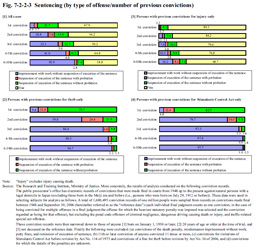| Previous Next Index Image Index Year Selection | |
|
|
2 Sentencing The 2007 edition of the White Paper on Crime analyzed the actual situation concerning repeat offenders using trial data and other information stored on computer in public prosecutors offices (See Chapter 3, Part 7 of the said White Paper). The results of that analysis were then used to observe how the sentencing changed as the total number of previous convictions of offenders increased. Fig. 7-2-2-3 shows the percent distribution of sentencing of all offenders, those with previous convictions for theft only, those with previous convictions for injury only, and those with previous convictions for Stimulants Control Act violations only by number of criminal records over approximately 60 years after World War II.For theft and Stimulants Control Act violations, 90% or more of persons who had repeated the same type of offense were granted suspension of execution of the sentence for their first offense, while about 60% of them for theft and about 80% of them for Stimulants Control Act violations were sentenced to imprisonment without suspension of execution of the sentence for the second offense. In a similar manner the sentencing for later offenses grew heavier as the number of previous convictions increased. Fig. 7-2-2-3 Sentencing (by type of offense/number of previous convictions) |
